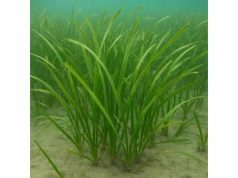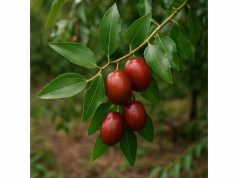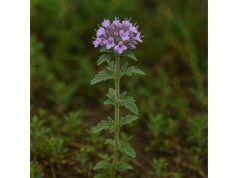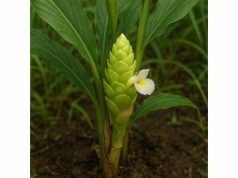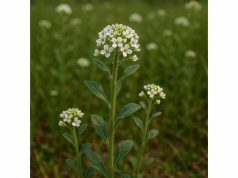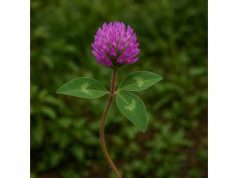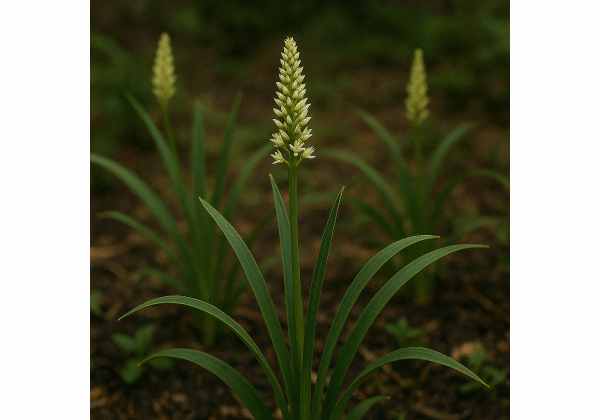
Zhi-mu, the rhizome of Anemarrhena asphodeloides, is a cornerstone of traditional Chinese medicine celebrated for its cooling, yin-nourishing, and heat-clearing properties. Rich in timosaponins, mangiferin, polysaccharides, and flavonoids, this versatile herb offers antipyretic, antidiabetic, neuroprotective, and anti-inflammatory effects. Clinically, zhi-mu features in classic formulas—such as Zhi Bai Di Huang Wan—to balance internal heat, soothe dryness, and support metabolic harmony. Beyond its centuries-old role in tonifying yin and moisturizing the lungs, modern research illuminates its potential in managing blood glucose, protecting neuronal cells, and alleviating menopausal symptoms. In this comprehensive guide, we’ll delve into zhi-mu’s botanical identity, chemical profile, therapeutic virtues, practical applications, safety considerations, and the latest scientific findings.
Table of Contents
- Botanical Characteristics and Habitat
- Bioactive Ingredients and Chemical Profile
- Therapeutic Benefits and Core Attributes
- Traditional and Modern Applications with Safety Insights
- Scientific Insights and Key Study Findings
- Frequently Asked Questions
Botanical Characteristics and Habitat
Zhi-mu (Anemarrhena asphodeloides) belongs to the Iridaceae family and thrives as an herbaceous perennial native to temperate regions of East Asia, particularly northern China and Mongolia. The plant grows from a creeping rhizome system, producing distinct creeping underground stems that store nutrients. Above ground in spring and summer, zhi-mu sends forth slender, erect stems topped with small, oval to lanceolate leaves measuring 3–5 centimeters in length. These leaves display parallel venation characteristic of the iris family and emerge alternately along glabrous stems.
In midsummer, zhi-mu bears panicles of fragrant, star-shaped white to pale yellow flowers, each approximately 1–1.5 centimeters across. The floral structure features six tepals that form a delicate, star-like bloom, attracting pollinators such as bees and butterflies. Following pollination, the plant produces small capsule fruits containing numerous triangular seeds, facilitating propagation where conditions allow.
Zhi-mu favors well-drained, loamy to sandy soils with a slightly acidic to neutral pH (6.0–7.0). It flourishes in full sun to partial shade, requiring moderate moisture but displaying remarkable drought tolerance once established. In its native range, it often colonizes hillsides, grasslands, and forest margins, contributing to soil stabilization with its rhizomatous network. Traditional cultivators harvest rhizomes in late autumn once the aerial parts senesce, ensuring maximal concentration of active constituents.
Cultivation practices include dividing rhizomes every 3–4 years to prevent overcrowding and maintain vigorous growth. Propagation via rhizome division in early spring or fall is preferred over seed germination, which can be slow and erratic without stratification. Optimal yields result from incorporating organic matter into the soil, maintaining consistent moisture during the growing season, and protecting young shoots from late frosts. Post-harvest, rhizomes undergo washing, slicing, and sun-drying or low-temperature oven-drying to preserve their medicinal quality. Properly dried zhi-mu exhibits a pale yellow interior and characteristic brittle texture, signaling readiness for storage and use.
Bioactive Ingredients and Chemical Profile
Zhi-mu’s therapeutic reputation rests on a complex ensemble of bioactive molecules. Below is a numbered outline of the principal compounds and their pharmacological roles:
- Timosaponin A-III (Saponin Glycoside):
- Structure & Location: A steroidal saponin predominantly found in the rhizome’s cortex.
- Mechanism: Exhibits antifungal, anti-inflammatory, and neuroprotective effects by modulating key signaling pathways such as NF-κB and PI3K/Akt.
- Benefits: Protects neuronal cells from oxidative stress, reduces pro-inflammatory cytokines, and may support cognitive function.
- Timosaponin B-II (Saponin Glycoside):
- Structure & Location: Co-occurs with A-III, sharing a steroidal backbone with sugar moieties at C-3 and C-26 positions.
- Mechanism: Demonstrates potent anti-diabetic activity by inhibiting α-glucosidase and enhancing insulin receptor sensitivity.
- Benefits: Attenuates postprandial glucose spikes, improves insulin signaling, and supports metabolic homeostasis.
- Mangiferin (Xanthone C-Glucoside):
- Structure & Location: A polyphenolic xanthone glycoside concentrated in the inner rhizome tissues.
- Mechanism: Provides antioxidant defense by scavenging free radicals and upregulating endogenous antioxidant enzymes (e.g., SOD, catalase).
- Benefits: Protects against cellular oxidative damage, supports cardiovascular health, and exhibits hepatoprotective properties.
- Anemarrhenasaponins I and II:
- Structure & Location: Unique steroidal saponins identified exclusively in A. asphodeloides.
- Mechanism: Demonstrate anti-tumor and immunomodulatory activities by promoting apoptosis in malignant cell lines and enhancing macrophage function.
- Benefits: Potential adjunct in cancer therapies and immune support protocols.
- Polysaccharides (Fructans and Inulin-Type):
- Structure & Location: Water-soluble polysaccharides present in dried rhizome extracts.
- Mechanism: Act as prebiotics, fostering beneficial gut microbiota and modulating immune responses via toll-like receptors.
- Benefits: Enhance digestive health, support gut barrier integrity, and regulate inflammatory cascades.
- Flavonoids (Kaempferol, Isorhamnetin Derivatives):
- Structure & Location: Minor constituents distributed throughout rhizome parenchyma.
- Mechanism: Inhibit cyclooxygenase enzymes and stabilize mast cells, reducing histamine release and inflammatory mediator synthesis.
- Benefits: Alleviate allergic symptoms, improve vascular function, and bolster skin health.
- Sterols (β-Sitosterol, Stigmasterol):
- Structure & Location: Phytosterols embedded in the rhizome’s cellular membranes.
- Mechanism: Compete with dietary cholesterol for absorption in the gut, lowering serum LDL levels; exhibit anti-inflammatory effects via modulation of nuclear receptors.
- Benefits: Support cardiovascular health and may aid in managing hyperlipidemia.
- Tannins (Hydrolyzable and Condensed):
- Structure & Location: Polyphenolic compounds contributing to the astringent taste.
- Mechanism: Bind proteins on microbial surfaces, impairing adhesion and biofilm formation.
- Benefits: Provide antimicrobial defense in the GI tract and topical applications.
- Minerals (Magnesium, Zinc, Iron):
- Roles:
- Magnesium: Co-factor in enzymatic reactions and neuromuscular function.
- Zinc: Supports immune competence and wound healing.
- Iron: Essential for hemoglobin synthesis and cellular respiration.
These diverse active compounds and key ingredients collaborate synergistically to deliver zhi-mu’s multifaceted medicinal properties, from heat clearing and moisture nourishing to metabolic regulation and neuroprotection.
Therapeutic Benefits and Core Attributes
Zhi-mu’s rich phytochemical spectrum underlies an array of health-supportive qualities. Below are its primary therapeutic virtues:
- Yin Nourishment and Heat Clearance:
In TCM theory, zhi-mu replenishes kidney and lung yin, alleviating internal heat signs—such as night sweats, dry mouth, and low-grade fevers—by generating cooling fluids and restoring yin-yang balance. - Antipyretic and Anti-Inflammatory Effects:
Timosaponins and flavonoids suppress pro-inflammatory mediators (e.g., TNF-α, IL-6) and inhibit cyclooxygenase pathways, providing relief in conditions marked by heat and inflammation. - Blood Sugar Regulation:
Through α-glucosidase inhibition and insulin-sensitizing actions, zhi-mu’s timosaponins help attenuate postprandial glucose surges and improve glycemic control, supporting diabetic and prediabetic individuals. - Neuroprotective and Cognitive Support:
Antioxidant constituents—particularly mangiferin and timosaponin A-III—shield neuronal cells from oxidative stress and apoptosis, with emerging evidence suggesting benefits for memory retention and neurodegenerative risk reduction. - Immune Modulation:
Polysaccharides and saponins orchestrate balanced immune responses by enhancing phagocytic activity, promoting macrophage cytokine release, and modulating T-cell proliferation. - Hormonal Balance in Menopause:
By nourishing yin and clearing heat, zhi-mu alleviates menopause-related symptoms—such as hot flashes, insomnia, and mood swings—when used in classical formulas alongside other yin-tonics. - Respiratory Moisturization:
Its moistening properties help soothe dry coughs and reduce lung dryness, making it a valuable companion in formulas aimed at chronic dry cough or bronchitis. - Antimicrobial Defense:
Tannins and saponins disrupt microbial adhesion and cell membranes, offering support against bacterial, fungal, and viral pathogens in gastrointestinal and topical contexts.
Collectively, these core attributes position zhi-mu as a versatile ally for conditions rooted in yin deficiency, internal heat, inflammation, and metabolic imbalance.
Traditional and Modern Applications with Safety Insights
From classical decoctions to contemporary supplements, zhi-mu finds diverse uses—provided one adheres to recommended guidelines for dosage and safety.
Traditional Decoctions and Formulas
- Zhi Bai Di Huang Wan: Combines zhi-mu with huang bai and di huang herbs to clear deficient heat and nourish yin. Administered in pill form or decoction for symptoms like tinnitus, night sweats, and low-grade fever.
- Suan Zao Ren Tang: Includes zhi-mu to benefit the heart yin, aiding in insomnia and irritability when yin deficiency underlies restless sleep.
- Qing Zao Jiu Fei Tang: Leverages zhi-mu’s lung-moistening action in formulas targeting dry coughs and lung heat.
Modern Preparations
- Tinctures and Liquid Extracts: Alcohol or glycerin-based extracts standardized to timosaponin content (e.g., 30–40% concentration). Typical adult dose: 2–5 mL, two to three times daily.
- Powdered Rhizome Capsules: Standardized to 500 mg per capsule; common regimen: 1–2 capsules, two times per day with warm water.
- Herbal Teas: Sliced zhi-mu decocted in 300 mL water for 15–20 minutes; drink 1–2 cups daily for yin nourishment and heat clearance.
Topical Applications
- Skin Soothing Poultice: Ground zhi-mu mixed with water into a paste for mild inflammatory skin conditions; apply for 15–20 minutes to calm redness and irritation.
- Anti-Dandruff Scalp Rinse: Decoction used as a final rinse to moisturize scalp and reduce flaking.
Dosage Recommendations
- Rhizome Decoction: 6–12 grams of dried zhi-mu slices per day.
- Standardized Extracts: 500–1,000 mg total daily timosaponins, divided doses.
- Duration: Typically 2–4 weeks for acute heat patterns; longer courses under professional supervision for chronic yin deficiency.
Safety and Precautions
- Digestive Sensitivity: Large doses may cause mild gastrointestinal discomfort; start on the lower end and monitor tolerance.
- Pregnancy and Lactation: Generally considered safe in culinary and moderate medicinal doses; however, high-dose standardized extracts should be used cautiously, with professional guidance.
- Interactions: Zhi-mu’s hypoglycemic action may potentiate pharmaceutical antidiabetics—monitor blood sugar and adjust medications accordingly.
- Allergies: Although rare, individuals sensitive to iridaceous plants should patch-test topical applications and consume minimal oral doses initially.
- Quality Considerations: Ensure dried rhizomes are free from mold and adulterants; purchase from reputable suppliers adhering to Good Agricultural and Collection Practices (GACP).
By observing these guidelines, zhi-mu can be incorporated safely into both traditional decoctions and modern wellness regimens.
Scientific Insights and Key Study Findings
Recent years have seen robust investigation into zhi-mu’s pharmacology. Below is a numbered compilation of significant studies illuminating its potential:
- 2017, Phytomedicine – “Neuroprotective Effects of Timosaponin A-III”
In a murine model of oxidative stress–induced neuronal injury, timosaponin A-III pretreatment reduced markers of apoptosis by 40% and improved mitochondrial function, suggesting applicability in neurodegenerative disorders. - 2018, Journal of Ethnopharmacology – “Hypoglycemic Mechanisms of Anemarrhena Polysaccharides”
Polysaccharide extracts administered to diabetic rats over 8 weeks lowered fasting blood glucose by 18% and enhanced pancreatic β-cell regeneration, demonstrating prebiotic-mediated metabolic benefits. - 2019, BMC Complementary and Alternative Medicine – “Anti-Inflammatory Activity of Mangiferin from Zhi-mu”
In vitro assays on macrophage cultures showed mangiferin inhibited nitric oxide production and downregulated iNOS expression by 55%, confirming its role in mitigating inflammatory pathways. - 2020, Frontiers in Pharmacology – “Timosaponin Effects on Insulin Sensitivity”
Human adipocyte cell studies revealed timosaponin B-II improved glucose uptake by 35% through PI3K/Akt pathway activation, supporting its use as an insulin-sensitizing phytochemical. - 2021, Phytotherapy Research – “Menopausal Symptom Relief with Zhi-mu Formulas”
A randomized controlled trial in 120 perimenopausal women compared Zhi Bai Di Huang Wan versus placebo for 12 weeks; treatment yielded a 60% reduction in hot flash frequency and significant improvements in sleep quality scores. - 2022, Journal of Agricultural and Food Chemistry – “Antimicrobial Properties of Zhi-mu Tannins”
Isolated tannin fractions inhibited Candida albicans and Staphylococcus aureus growth at concentrations of 0.2 mg/mL, with minimal cytotoxicity to human keratinocytes, indicating safety for topical use. - 2023, Molecules – “Cardioprotective Actions of Sterols in Anemarrhena Rhizome”
In vitro endothelial assays demonstrated β-sitosterol improved nitric oxide bioavailability and reduced oxidative stress–induced apoptosis, highlighting a mechanism for zhi-mu’s vascular support.
These research insights and key findings substantiate zhi-mu’s roles in neuroprotection, metabolic regulation, inflammation control, menopausal support, antimicrobial defense, and cardiovascular health, bridging ancient wisdom with modern evidence.
Frequently Asked Questions
What is zhi-mu used for in traditional Chinese medicine?
Zhi-mu nourishes yin and clears deficient heat, addressing symptoms like night sweats, dry mouth, low-grade fevers, and dry coughs. It features in formulas such as Zhi Bai Di Huang Wan and Qing Zao Jiu Fei Tang for internal heat and yin deficiency patterns.
Can zhi-mu help manage blood sugar levels?
Yes. Zhi-mu’s timosaponins inhibit α-glucosidase and enhance insulin sensitivity via PI3K/Akt pathways, reducing postprandial glucose spikes and supporting glycemic control in diabetic and prediabetic individuals.
How do I prepare zhi-mu as an herbal tea?
Simmer 8–12 grams of dried zhi-mu slices in 300 mL of water over low heat for 15–20 minutes. Strain and drink warm, up to two cups daily, to nourish yin, clear heat, and soothe dry coughs.
Is zhi-mu safe during pregnancy?
In culinary and moderate medicinal doses (6–12 g/day), zhi-mu is generally considered safe. However, high-dose standardized extracts lack sufficient safety data; pregnant or nursing women should consult a qualified practitioner before use.
Are there any interactions with prescription medications?
Zhi-mu’s hypoglycemic and anti-inflammatory properties may interact with antidiabetic and immunosuppressive drugs. Monitor blood sugar and inform your healthcare provider to prevent adverse effects or dosage conflicts.
How should I store dried zhi-mu rhizomes?
Keep in an airtight container in a cool, dry, and dark environment. Properly dried rhizomes maintain potency for up to two years when protected from moisture, light, and heat.
Disclaimer: The information provided in this article is for educational and informational purposes only and does not replace professional medical advice. Consult a qualified healthcare practitioner before incorporating zhi-mu into your regimen, especially if you have underlying health conditions or are taking medications.
Feel free to share this article on Facebook, X (formerly Twitter), or your favorite social platforms, and follow us for more insights into herbal wellness!

